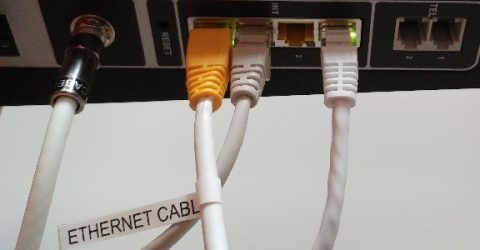Ethernet: a beginner’s guide

With the sheer volume of wireless devices available today, we sometimes forget that home broadband systems also support physical connections to the internet via the use of Ethernet cables.
All modems and wireless routers have square sockets measuring around a third of an inch on the back.
These numbered ports are Ethernet connections. They provide a high-speed link to the information superhighway for larger electronic devices.
And yet many people choose not to use them.
So what do these connections do, and why are they important?
In the Ether
Ethernet cables establish a physical link between a web-enabled device and a broadband router.
These chunky and colourful cables haven’t changed much since their initial development back in the 1970s.
They provide a rapid and secure method of transmitting data over a network, free of interference.
When plugged into a broadband router, Ethernet cables provide what politicians might refer to as a strong and stable connection. They allow devices to connect to the internet at the fastest possible line speed.
The delay between requesting an action and receiving a response (known as latency) is minimised. This is crucial for activities like video calling, or online gaming.
Before starting any troubleshooting, ISP technical support teams ask whether your computer plugs into your router via Ethernet because this is the best connection possible.
That might involve trailing wires across the floor. Unfortunately there’s no hiding the fact Ethernet cables are bulky and rather unattractive.
Ethernet connection vs wireless
When a device connects to a broadband router over WiFi, it compromises the achievable connection speed.
Information travels more slowly through the air than it does along cables. It’s also more prone to interference.
Issues might include other devices using similar bandwidth frequencies, a lack of range from the wireless router, or simply signal drop-outs. Electromagnetic fields from baby monitors also inhibit WiFi connections.
As a result, WiFi could be delivering speeds well below those the router is capable of delivering.
There are also greater security concerns, since third parties can spy on wireless data transfers more easily than information that moves via a hardwired cable.
Indeed, the wider world has little effect on Ethernet cables. For instance, they’ll only slow down when an internet connection is being used by multiple devices at the same time.
The 802.11n WiFi standard has a maximum connection speed of 150Mbps, whereas a Cat6 Ethernet cable could transmit data at up to 10Gbps. Even older Cat5e cables achieve 1Gbps.
That ensures an Ethernet-connected device receives the fastest connection speed available through that network and router.
The Power and the glory
Of course, not every device supports Ethernet. Sockets are generally only found on larger appliances like televisions, games consoles, desktop computers and TV set top boxes.
Powerline adaptors represent a worthwhile investment if these devices are in a different room to the router.
The mains adaptor plugs resemble lamp-timers and plug into a power socket beside the router. Then they connect to the router via an Ethernet cable.
This effectively turns a property’s electrical circuits into high-speed data networks.
When a satellite Powerline adaptor plugs into another mains socket on the same network (which usually covers an entire house) a hardwired link to the router is established.
Information passes along these electrical circuits without affecting their normal role as plug sockets.
Data transfer speeds are significantly better than over WiFi, though not as rapid as a direct Ethernet link.
Costing as little as £25 from your local catalogue retailer, Powerline adaptors eliminate the periodic dropouts or sudden fluctuations in line speed often experienced by wireless devices.






